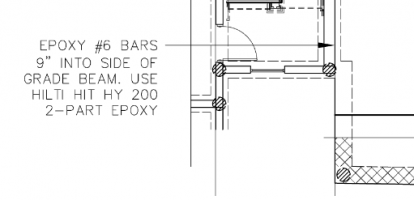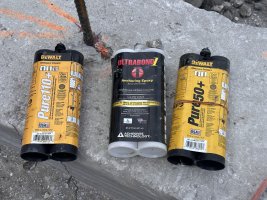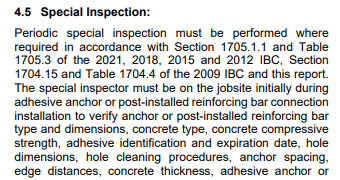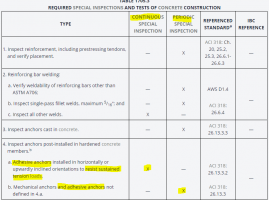-
Welcome to The Building Code Forum
Your premier resource for building code knowledge.
This forum remains free to the public thanks to the generous support of our Sawhorse Members and Corporate Sponsors. Their contributions help keep this community thriving and accessible.
Want enhanced access to expert discussions and exclusive features? Learn more about the benefits here.
Ready to upgrade? Log in and upgrade now.
You are using an out of date browser. It may not display this or other websites correctly.
You should upgrade or use an alternative browser.
You should upgrade or use an alternative browser.
When the Contractor Does Not Follow Specs from the Engineer
- Thread starter jar546
- Start date
fatboy
Administrator
Require the designing engineer provide an acceptance document.
Yankee Chronicler
REGISTERED
The permit is a permit to build what is called for in the "approved" construction documents. The substitution is a reject. The engineer should provide an engineered judgment that the substituted products (all three of them!) are equal to the specified product. If the engineer is not willing to provide that -- sealed and signed -- then the work gets rejected.
Caveat: Were project specifications provided, reviewed, and approved at the time the permit was issued? It's very common for specs to list one or two alternate products. If that was the case here, then any product named in the spec would be considered to be in compliance. However, I think it would be extremely unlikely that an engineer would specify two different DeWalt products for the same application.
Epoxy bonding of rebar is a can of worms. For those old enough to remember the collapse of the roof of Boston's "Big Dig" tunnel, the failure was found to have occurred because the contractor substituted the epoxy that held the suspended roof panels over the highway. The specified product was appropriate for overhead use -- the substitute product used was not.
Caveat: Were project specifications provided, reviewed, and approved at the time the permit was issued? It's very common for specs to list one or two alternate products. If that was the case here, then any product named in the spec would be considered to be in compliance. However, I think it would be extremely unlikely that an engineer would specify two different DeWalt products for the same application.
Epoxy bonding of rebar is a can of worms. For those old enough to remember the collapse of the roof of Boston's "Big Dig" tunnel, the failure was found to have occurred because the contractor substituted the epoxy that held the suspended roof panels over the highway. The specified product was appropriate for overhead use -- the substitute product used was not.
Require the contractor to get an acceptance document from the engineer.Require the designing engineer provide an acceptance document.
Genduct
REGISTERED
You said: "Caveat: Were project specifications provided, reviewed, and approved"The permit is a permit to build what is called for in the "approved" construction documents. The substitution is a reject. The engineer should provide an engineered judgment that the substituted products (all three of them!) are equal to the specified product. If the engineer is not willing to provide that -- sealed and signed -- then the work gets rejected.
Caveat: Were project specifications provided, reviewed, and approved at the time the permit was issued? It's very common for specs to list one or two alternate products. If that was the case here, then any product named in the spec would be considered to be in compliance. However, I think it would be extremely unlikely that an engineer would specify two different DeWalt products for the same application.
Epoxy bonding of rebar is a can of worms. For those old enough to remember the collapse of the roof of Boston's "Big Dig" tunnel, the failure was found to have occurred because the contractor substituted the epoxy that held the suspended roof panels over the highway. The specified product was appropriate for overhead use -- the substitute product used was not.
It is that "approved" word that I think is troublesome and a landmind. We have to remember we are MERELY the Reviewer, and later the Inspector, and look to see if Plans (and specs?) are consistent with the Minimum, Safety aspects of the Code. We are historically about Public Safety. So the Job shouldn't Blow-Up or Fall Down. We are Not the Design Professional. When we, as experienced Construction people, see or somehow it comes to our attention, that something isn't consistent with the Construction doc, of course, we need a "Clarification" The other area is that "Good Workmanship", judgement call. And God knows we certainly are not judging "Best Practices" or what constitutes "A Good Job" judgement thing
Yankee Chronicler
REGISTERED
You said: "Caveat: Were project specifications provided, reviewed, and approved"
It is that "approved" word that I think is troublesome and a landmind. We have to remember we are MERELY the Reviewer, and later the Inspector, and look to see if Plans (and specs?) are consistent with the Minimum, Safety aspects of the Code.
I think you mean "land mine." As a one-time Army combat engineer, I know more about those than many of my colleagues.
Yes, I know that "approved" is a loaded word. I remind you of the language in the code:
IBC:
[A] 107.3.1 Approval of construction documents. When the
building official issues a permit, the construction documents
shall be approved, in writing or by stamp, as “Reviewed for
Code Compliance.” One set of construction documents so
reviewed shall be retained by the building official. The other
set shall be returned to the applicant, shall be kept at the site of
work and shall be open to inspection by the building official or
a duly authorized representative.
IRC:
R106.3.1 Approval of construction documents. Where the
building official issues a permit, the construction documents
shall be approved in writing or by a stamp that states
“REVIEWED FOR CODE COMPLIANCE.” One set of
construction documents so reviewed shall be retained by the
building official. The other set shall be returned to the applicant,
shall be kept at the site of work and shall be open to
inspection by the building official or a duly authorized
representative.
IPC:
[A] 106.5.1 Approved construction documents. When
the code official issues the permit where construction
documents are required, the construction documents shall
be endorsed in writing and stamped “APPROVED.” Such
approved construction documents shall not be changed,
modified or altered without authorization from the code
official. Work shall be done in accordance with the
approved construction documents.
The code official shall have the authority to issue a
permit for the construction of a part of a plumbing system
before the entire construction documents for the whole
system have been submitted or approved, provided that
adequate information and detailed statements have been
filed complying with all pertinent requirements of this
code. The holders of such permit shall proceed at their
own risk without assurance that the permit for the entire
plumbing system will be granted.
IMC:
[A] 106.4.1 Approved construction documents. When
the code official issues the permit where construction
documents are required, the construction documents shall
be endorsed in writing and stamped “APPROVED.” Such
approved construction documents shall not be changed,
modified or altered without authorization from the code
official. Work shall be done in accordance with the
approved construction documents.
The code official shall have the authority to issue a
permit for the construction of part of a mechanical system
before the construction documents for the entire system
have been submitted or approved, provided that adequate
information and detailed statements have been filed
complying with all pertinent requirements of this code.
The holder of such permit shall proceed at his or her own
risk without assurance that the permit for the entire
mechanical system will be granted.
The I-codes are not even consistent within themselves with regard to the use of the term "approved." Despite an attempt to shift away from "approving" construction documents in the IBC and IRC, the IMC and IPC still explicitly use the term "Approved." And even the IBC and IRC language rather plainly states that "Reviewed for code compliance" means "Approved."
I don't have the answer. I'm not a lawyer.
fatboy
Administrator
Require the contractor to get an acceptance document from the engineer.
Splitting hairs........require the RDP ultimately accept the alternative, or not.
Yankee Chronicler
REGISTERED
Splitting hairs........require the RDP ultimately accept the alternative, or not.
It's a lot more than splitting hairs. Using epoxy to anchor rebar is a structural application. Using the wrong epoxy can result in structural failure. Tell the people who were killed when the roof of the Big Dig tunnel fell that the choice of epoxy was just "splitting hairs."
There are times when splitting those hairs is what we get paid to do.
Yes it’s splitting hairs, but it’s the contractors responsibility to follow the specs or get approval to deviate.Splitting hairs........require the RDP ultimately accept the alternative, or not.
I am curious about the special inspection requirement. Given who’s territory this is in, there’s a public flogging in the future.
fatboy was splitting a different hair. His statement had nothing to do with the substitution of epoxy. fatboy was splitting a hair between a contractor and an engineer… so you are wrong and Jeff likes that.It's a lot more than splitting hairs. Using epoxy to anchor rebar is a structural application. Using the wrong epoxy can result in structural failure. Tell the people who were killed when the roof of the Big Dig tunnel fell that the choice of epoxy was just "splitting hairs."
There are times when splitting those hairs is what we get paid to do.
Last edited:
steveray
SAWHORSE
Yankee Chronicler
REGISTERED
Looking up the DeWalt product pages for those products, both the 50+ and 110+ include a caveat: "Oversized hammer-drilled holes in concrete, for short term loading only (see www.DEWALT.com)"
That right there is enough to suggest putting the brakes on until some engineer blesses the substitution. This is exactly the problem that caused/allowed the roof of the Big Dig to collapse.
Both DeWalt products have ICC ESR approvals, and they are NOT approved under the same report. Aside from the name (and probably the price), that tells me they are not the same product.
That right there is enough to suggest putting the brakes on until some engineer blesses the substitution. This is exactly the problem that caused/allowed the roof of the Big Dig to collapse.
Both DeWalt products have ICC ESR approvals, and they are NOT approved under the same report. Aside from the name (and probably the price), that tells me they are not the same product.
Yankee Chronicler
REGISTERED
It looks like the Hilti product named on the drawing is suitable for use in hammer-drilled holes:
 www.hilti.com
www.hilti.com
HIT-HY 200-A V3 Adhesive anchor - Chemical Anchors - Hilti USA
Hilti Chemical Anchors - HIT-HY 200-A V3 Adhesive anchor - Ultimate-performance injection mortar - fast-cure adhesive anchor approved for structural base plate anchoring and post-installed rebar connections in concrete
You said: "Caveat: Were project specifications provided, reviewed, and approved"
It is that "approved" word that I think is troublesome and a landmind. We have to remember we are MERELY the Reviewer, and later the Inspector, and look to see if Plans (and specs?) are consistent with the Minimum, Safety aspects of the Code. We are historically about Public Safety. So the Job shouldn't Blow-Up or Fall Down. We are Not the Design Professional. When we, as experienced Construction people, see or somehow it comes to our attention, that something isn't consistent with the Construction doc, of course, we need a "Clarification" The other area is that "Good Workmanship", judgement call. And God knows we certainly are not judging "Best Practices" or what constitutes "A Good Job" judgement thing
The building department approves the permit. In this context "approve" is the appropriate term.
If the work is not in accordance with the permit documents then it either must be made to comply with the permit or the design professional will need to submit a change order, modifying the permit documents, that will resolve the non-compliance.
Require the contractor to get an acceptance document from the engineer.
The references to the engineer misrepresent the engineers role.
It is the Owner, not the contractor, that involves the engineer of record. If the engineer determines that the proposed product/changes are appropriate the engineer can prepare revisions to the permit documents which can then be submitted to the building department. Once the revisions have been approved by the building department these revised documents become the official permit documents.
tmurray
SAWHORSE
I agree with Mark K on this one. It is not the role of the building inspection department to dictate how this must be fixed, simply that it does not comply with the approved specifications. Certainly, the building inspector can provide guidance in how this could be fixed, but selecting the appropriate fix is ultimately at the discretion of the owner or their representative. I've been involved in situations like this where the owner was not accepting of any deviation and the contractor had to remove the defective work and replace it. It seems harsh, but the contractor paid much more attention to the plans and specs after that.
Yankee Chronicler
REGISTERED
The building department approves the permit. In this context "approve" is the appropriate term.
The code language (which I reproduced above) says the building department "approves" the construction documents. Nowhere does the code say the buiklding department "approves" a permit [application]. The codes says that when the building department has "approved" the construction documents, it shall "issue" a permit.
[A] 105.3.1 Action on application. The building official shall
examine or cause to be examined applications for permits and
amendments thereto within a reasonable time after filing. If the
application or the construction documents do not conform to
the requirements of pertinent laws, the building official shall
reject such application in writing, stating the reasons therefor.
If the building official is satisfied that the proposed work
conforms to the requirements of this code and laws and ordinances
applicable thereto, the building official shall issue a
permit therefor as soon as practicable.
Yankee Chronicler
REGISTERED
I agree with Mark K on this one. It is not the role of the building inspection department to dictate how this must be fixed, simply that it does not comply with the approved specifications. Certainly, the building inspector can provide guidance in how this could be fixed, but selecting the appropriate fix is ultimately at the discretion of the owner or their representative. I've been involved in situations like this where the owner was not accepting of any deviation and the contractor had to remove the defective work and replace it. It seems harsh, but the contractor paid much more attention to the plans and specs after that.
It is not the role of the building department to dictate how the unauthorized substitution gets fixed, but it IS the role of the building department to require THAT it be fixed -- unless the registered design professional in responsible charge determines that the substitution is fully equal and will perform as intended, in which case amended construction documentation should be submitted for the record.
I forgot … the Engineer sits at the right hand of God and cannot be bothered to interact with mere mortals, the great unwashed caste of contractors.The references to the engineer misrepresent the engineers role.
It is the Owner, not the contractor, that involves the engineer of record.
What if it’s a design-build, and the gc engaged the engineer?
And more to the point, the contractor has the ability to submit an RFI directly to the design professionals for clarification of misunderstood items. Notice I didn’t say “unclear” because well all know everything the Engineer publishes is perfect, the fault lies with caste.
Inspector Gadget
REGISTERED
Lots of discussion over what's obvious: engineer specified a product. Contractor used a different product.
I'd offer two solutions:
a) Remove bars and install with the specified product as outlined in the plans, or
b) Obtain a judgment from the designing engineer that the product used is suitable in this application.
No work shall be done that obscures, or connects to the bars until the written approval of the building inspector is provided.
I'd offer two solutions:
a) Remove bars and install with the specified product as outlined in the plans, or
b) Obtain a judgment from the designing engineer that the product used is suitable in this application.
No work shall be done that obscures, or connects to the bars until the written approval of the building inspector is provided.
Yankee Chronicler
REGISTERED
What if it’s a design-build, and the gc engaged the engineer?
Doesn't matter. The engineer is still the licensed design professional, and is still responsible/liable if the structure fails. Even if the GC and the owner are the same entity, a change to a specified product should still be submitted to the RDP for approval, and then to the building department as an amended construction document.
Since embedding of rebars is subject to special inspection, where was the special inspector when the wrong adhesive product was used?
And more to the point, the contractor has the ability to submit an RFI directly to the design professionals for clarification of misunderstood items. Notice I didn’t say “unclear” because well all know everything the Engineer publishes is perfect, the fault lies with caste.
An RFI is a request for information -- clarification of something that's unclear. In this case, there's nothing unclear about "HILTI HIT HY 200 2-PART EPOXY." If the GC (or the subcontractor) wanted to use a DeWalt or some other brand of epoxy, they should have submitted a request for a substitution. In this case, though, it appears they just used whatever they happened to have on the truck that day.
Tim Mailloux
REGISTERED
keep in mind the contractor could have submitted a product substitution request to the RDP for review and approval. Material changes like this are also common during the product data / shop drawing submittal phase..................or the contractor is being cheap and trying to sneak one by.
Interesting they used 3 different products, and left the evidence lying around.......or the contractor is being cheap and trying to sneak one by.




